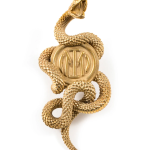
Biscione: Inter's symbol and nickname
Do you know his origin story?
April 12th, 2023
115 years of history do not go unnoticed. Inter has been one of the most recognisable brands in Italian and European football for several decades, and the Biscione is a key part of that. It is no coincidence, in fact, that the recent design celebrating Inter's 115th anniversary features a Biscione modelled to resemble the anniversary number wrapped around the current Nerazzurri coat of arms. However, few know the history of this symbol and the complexities surrounding its adoption, and it is undoubtedly something to be discovered.
First and foremost, it is crucial to understand what the Biscione really means and represents. The Biscione has been one of, if not the most important symbol for the city of Milan for more than 700 years. The animal appeared on the coat of arms of the Visconti family, which gained control over Milan as far back as 1277. And although this family died out in 1447, the Duchy of Milan decided to keep the Biscione in the city's coat of arms, and today, centuries later, it is still one of the most recognisable and characteristic symbols of the Lombard capital.
Now let's talk about Inter, as we all know by now, the roots of Inter date back to 1908. The founders - mostly former Milan managers - were against certain regulations that limited the number of foreign players eligible to wear the Rossoneri jersey. The Foot-Ball Club Internazionale was thus founded for these and other regions and, as the name and context suggests, the club was strongly focused on being international, with the founders officially declaring themselves 'brothers of the world' to seal the importance of the chosen name.
Precisely because of this, the 'Biscione' was punctually left out and discarded as a potential symbol and nickname for the fledgling Milanese team. Since the focus was on being multicultural and international, the club strongly wanted to avoid any connotation to its local origins. When Benito Mussolini and fascism came to power, however, things had to change. As a great Italian nationalist, Mussolini imposed an intense Italianisation on all aspects of life, which is why Inter's international philosophy was blamed and deemed inappropriate and obviously downgraded, following the wrong dictates of the time.
The first change came in 1925, when the 'Biscione' was incorporated into Inter's logo for the first time, celebrating the club's Milanese heritage instead of its international status. In 1928, the name itself was replaced with 'Ambrosiana', referring to Milan's patron saint Ambrose (Sant Ambroeus in Milanese dialect), thus neutralising the essence and soul of the Nerazzurri club. These forced elements were maintained until the end of World War II, and although the name Internazionale was reinstated in 1945 (deemed too important for the team's identity), the Biscione was retained, both as a nickname and as a symbol.
Since then, Inter and Biscione have been inseparable, each becoming synonymous with the other. For example, the famous snake was also the only element of the club's coat of arms between 1960-1963 and 1979-1989. This allowed it to become firmly established in Inter's history and to appear on unforgettable uniforms, such as the one from the record-breaking 1988-1989 season, produced by Uhlsport and worn by legends such as Lothar Matthäus, Giuseppe Bergomi and Andreas Brehme. Over the years, we have witnessed several celebrations of Inter's Milanese origins centred around the Biscione, and although the international philosophy is still present, it is difficult to imagine this team without its iconic and historic symbol.












